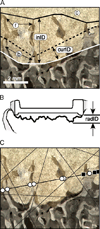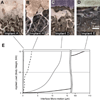Increased initial cement-bone interlock correlates with reduced total knee arthroplasty micro-motion following in vivo service
- PMID: 24795171
- PMCID: PMC4100248
- DOI: 10.1016/j.jbiomech.2014.04.016
Increased initial cement-bone interlock correlates with reduced total knee arthroplasty micro-motion following in vivo service
Abstract
Aseptic loosening of cemented tibial components in total knee arthroplasty (TKA) has been related to inadequate cement penetration into the trabecular bone bed during implantation. Recent postmortem retrieval work has also shown there is loss of interlock between cement and bone by resorption of trabeculae at the interface. The goal of this study was to determine if TKAs with more initial interlock between cement and bone would maintain more interlock with in vivo service (in the face of resorbing trabeculae) and have less micro-motion at the cement-bone interface. The initial (created at surgery) and current (after in vivo service) cement-bone interlock morphologies of sagittal implant sections from postmortem retrieved tibial tray constructs were measured. The implant sections were then functionally loaded in compression and the micro-motion across the cement-bone interface was quantified. Implant sections with less initial interdigitation between cement and bone and more time in service had less current cement-bone interdigitation (r(2)=0.86, p=0.0002). Implant sections with greater initial interdigitation also had less micro-motion after in vivo service (r(2)=0.36, p=0.0062). This work provides direct evidence that greater initial interlock between cement and bone in tibial components of TKA results in more stable constructs with less micro-motion with in vivo service.
Keywords: Knee arthroplasty; Loosening; Micro-motion; Postmortem; Radiolucent lines.
Copyright © 2014 Elsevier Ltd. All rights reserved.
Conflict of interest statement
Timothy Izant serves as a paid consultant for Stryker Orthopaedics for clinical total joint replacement studies unrelated to the content of this manuscript. All other authors have no conflicts of interest to disclose.
Figures







References
-
- Bert JM, McShane M. Is it necessary to cement the tibial stem in cemented total knee arthroplasty? Clin. Orthop. Relat. Res. 1998;356:73–78. - PubMed
-
- Cawley DT, Kelly N, McGarry JP, Shannon FJ. Cementing techniques for the tibial component in primary total knee replacement. Bone Joint J. 2013;95-B:295–300. - PubMed
-
- Charnley J. The reaction of bone to self-curing acrylic cement. A long-term histological study in man. J. Bone Joint Surg. Br. 1970;52:340–353. - PubMed
-
- D’Lima DD, Patil S, Steklov N, Chien S, Colwell CW., Jr in vivo knee moments and shear after total knee arthroplasty. J. Biomech. 2007;40(Suppl. 1):S11–S17. - PubMed
-
- Gebert de Uhlenbrock A, Puschel V, Puschel K, Morlock MM, Bishop NE. Influence of time in-situ and implant type on fixation strength of cemented tibial trays—a post mortem retrieval analysis. Clin. Biomech. (Bristol, Avon) 2012;27:929–935. - PubMed
Publication types
MeSH terms
Substances
Grants and funding
LinkOut - more resources
Full Text Sources
Other Literature Sources
Medical

